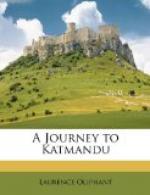Musk, procured from the musk-deer, is a most valuable article of commerce, and the present trade is exceedingly lucrative; of very inconsiderable bulk, and of great intrinsic worth, it is one of the few things that can be imported into India with a profit. It there fetches enormous prices; a small musk necklace, which I saw in the possession of the Minister, and which certainly was not a foot long, was valued at 25 pounds. It is very seldom, however, that musk can be procured unadulterated. It is not, however, so much as an ornament, as a medicine, that we should use this now costly substance.
But the most valuable productions at present imported from Thibet are mineral. Immense quantities of salt are brought over the Himalayas on sheep’s backs; gold-dust, borax, sulphur, antimony, arsenic, orpiment, and medicinal drugs are also imported into Nepaul.
The animals which abound in these cold regions, and which might be worth importing, are musk-deer, sheep, shawl-goats, chowrie bullocks, falcons, pheasants—in fact, it would be hopeless to attempt to enumerate all those productions, animal, vegetable, and mineral, which are now scarcely known except by name, but which will doubtless some day be objects of traffic and commercial enterprise. For instance, there are various medicinal drugs and dyes (among which may be mentioned madder and spikenard) which are said to exist, but are now almost totally unknown.
Among the present articles of import are embroideries, taffetas, chintz, silk, cotton, cloth, carpets, cutlery, sandalwood, tobacco, conch-shells, soap, etc. Surely it is no very extravagant flight of imagination to suppose that the day may yet come when the unattainable and almost unknown productions of the trans-Himalayan regions will be transported across that mighty range, in well-appointed carriages, over macadamised mountain-passes; and the noble work of the scientific engineer will thus supersede the flocks of heavily-laden sheep, driven by uncivilized and ill-clothed Bootyas, who, “impelled by the force of circumstances over which they have no control,” will don their smockfrocks and turn draymen; when the traveller, going to the coach-office, Durbar-square, Katmandu, may book himself in the royal mail through to H’Lassa, where, after a short residence at the Grand Lama Hotel, strongly recommended in Murray’s ‘Handbook for the Himalayas,’ he may wrap himself in his fur bukkoo, and, taking his seat in a first-class carriage on the Asiatic Central Railway, whisk away to Pekin, having previously telegraphed home, via St. Petersburg, that he proposes returning through North America, and will, therefore, probably be detained a few hours longer than he had anticipated.
Such a state of things we may not live to see, but it is by no means unlikely that ere long a railway may run from Calcutta to the northern frontier of British India; so that, when Nepaul is thrown open to European enterprise, its costly productions will be easily and cheaply transported to the nearest port, while the now almost uncivilized Nepaulese would obtain European luxuries unknown to any of them except Jung Bahadoor and his travelled suite.




